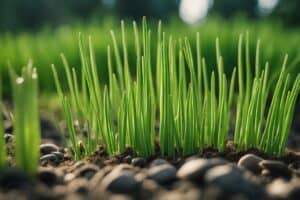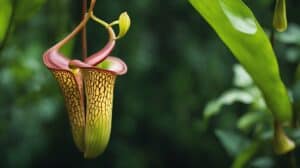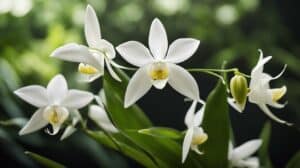The Golden Daphne, also known as Edgeworthia Chrysantha, is a beautiful and fragrant plant that is native to China, Japan, and Nepal. This deciduous shrub is highly sought after for its striking yellow flowers that bloom in late winter and early spring. In this article, we will discuss some growing tips for the Golden Daphne to help you cultivate a healthy and vibrant plant.

One of the most important things to keep in mind when growing the Golden Daphne is its preferred growing conditions. This plant thrives in moist, well-draining soil that is rich in organic matter. It also prefers partial shade to protect it from direct sunlight, which can scorch its leaves. By providing the right growing conditions, you can ensure that your Golden Daphne will grow strong and healthy.
Another important aspect of growing the Golden Daphne is pruning. This shrub should be pruned immediately after flowering to promote new growth and maintain its shape. It is also important to remove any dead or damaged branches to prevent the spread of disease. With proper pruning, your Golden Daphne can remain healthy and beautiful for years to come.
Understanding Edgeworthia Chrysantha
Origins and Characteristics
Edgeworthia chrysantha, commonly known as the Golden Daphne, is a deciduous shrub that belongs to the Thymelaeaceae family. It is native to China, Japan, and the Himalayas, where it grows in mountainous regions at elevations ranging from 500 to 3,500 meters. The shrub can reach a height of up to 2 meters and a spread of up to 3 meters.
The leaves of Edgeworthia chrysantha are arranged alternately on the stem and are oval-shaped with a pointed tip. They are about 10-20 cm long and 5-10 cm wide. The shrub produces fragrant, yellow flowers in late winter or early spring, before the leaves emerge. The flowers are arranged in clusters and have a pleasant scent that is reminiscent of honey.
Common Names and Varieties
Edgeworthia chrysantha is commonly known as the Golden Daphne, Paper Bush, or Yellow Daphne. There are several varieties of Edgeworthia chrysantha, including ‘Akebono’, which has pink flowers, and ‘Nanjing Gold’, which has golden-yellow flowers.
The Golden Daphne is a popular ornamental plant that is grown for its fragrant flowers and attractive foliage. It is suitable for growing in USDA hardiness zones 7-9 and prefers a well-drained soil that is rich in organic matter. The shrub is relatively low-maintenance and can be pruned after flowering to maintain its shape and size.
In summary, Edgeworthia chrysantha is a beautiful and fragrant shrub that is native to Asia. It is commonly known as the Golden Daphne, Paper Bush, or Yellow Daphne and produces fragrant, yellow flowers in late winter or early spring. There are several varieties of Edgeworthia chrysantha, including ‘Akebono’ and ‘Nanjing Gold’.
Cultivation Essentials

Choosing the Right Location
The Golden Daphne, also known as Edgeworthia Chrysantha, requires a partially shaded location. It thrives in a spot that receives morning sun and afternoon shade. Avoid planting it in a location that receives direct sunlight for an extended period as it can damage the plant. The Golden Daphne is also sensitive to wind, so it’s best to plant it in a location that is sheltered from strong winds.
Soil Requirements and Preparation
The Golden Daphne grows best in well-draining soil that is rich in organic matter. Before planting, it’s important to prepare the soil by digging a hole that is twice the size of the root ball. Mix in compost or well-rotted manure to the soil to improve drainage and add nutrients. Avoid planting in soil that is compacted or heavy in clay, as it can lead to root rot.
Planting Procedures
When planting The Golden Daphne, ensure that the top of the root ball is level with the soil surface. Backfill the hole with the prepared soil and gently firm it around the base of the plant. Water thoroughly to settle the soil and remove any air pockets. Mulch around the base of the plant to retain moisture and suppress weed growth. Water regularly during the first growing season to establish a healthy root system.
Following these cultivation essentials will help ensure that The Golden Daphne thrives in your garden. With the right location, soil preparation, and planting procedures, you can enjoy the beautiful blooms and fragrance of this stunning plant.
Ongoing Care and Maintenance

Watering and Feeding
The Golden Daphne requires regular watering to keep the soil moist but not waterlogged. It is important to avoid letting the soil dry out completely, but overwatering can lead to root rot. During the growing season, it is recommended to water the plant deeply once or twice a week. In the winter months, reduce watering to once every two to three weeks.
Feeding the plant with a balanced fertilizer during the growing season can help promote healthy growth and flowering. Use a slow-release fertilizer or a liquid fertilizer every four to six weeks. Avoid fertilizing the plant during the winter months.
Pruning and Shaping
Pruning the Golden Daphne is not necessary, but it can help maintain a tidy shape and promote healthy growth. It is recommended to prune the plant after flowering in the spring. Remove any dead or damaged branches, as well as any branches that are crossing or rubbing against each other.
To shape the plant, prune the tips of the branches to encourage bushier growth. You can also remove any branches that are growing in an undesirable direction. Avoid pruning too much at once, as this can stress the plant and affect its growth.
Pest and Disease Management
The Golden Daphne is relatively pest and disease resistant, but it can still be affected by common garden pests such as aphids and spider mites. Regularly inspect the plant for any signs of infestation, such as distorted leaves or webbing.
To manage pests, use an insecticidal soap or neem oil spray. Apply the spray according to the instructions on the label, and repeat as necessary.
The Golden Daphne can also be affected by fungal diseases such as powdery mildew. To prevent fungal infections, avoid overhead watering and ensure good air circulation around the plant. If you notice any signs of fungal disease, remove any affected leaves and treat the plant with a fungicide spray.
Propagation Techniques

Propagation of Edgeworthia Chrysantha can be done through various methods, including seed propagation, division, and softwood cuttings. Each technique has its own advantages and disadvantages, but all can be successful with proper care and attention.
Seed Propagation
Propagation through seeds is the most common method for Edgeworthia Chrysantha. The seeds should be collected when they are fully ripe and sown in a well-draining soil mix. The seeds should be sown at a depth of about 1 cm and kept moist until germination, which can take up to 6 weeks. Once the seedlings have developed their first set of true leaves, they can be transplanted into individual containers or directly into the ground.
Division
Division is another propagation method that can be used for Edgeworthia Chrysantha. This method involves dividing the plant into smaller sections and replanting them in new locations. This can be done in the spring or fall, and the plant should be well-watered before and after the process to reduce stress.
Softwood Cuttings
Propagation through softwood cuttings is a method that can be used in the spring or early summer. Softwood cuttings should be taken from the current season’s growth and planted in a well-draining soil mix. The cuttings should be kept moist and in a warm, humid location until they have developed roots. Once the cuttings have rooted, they can be transplanted into individual containers or directly into the ground.
It is important to note that propagation can be a delicate process and requires attention to detail. It is recommended to research and follow specific instructions for each propagation method to ensure the best chance of success.
Frequently Asked Questions

How should I care for an Edgeworthia plant?
Edgeworthia Chrysantha requires well-draining soil that is rich in organic matter. It prefers a partially shaded location that is protected from strong winds. Watering should be done regularly, but not excessively, to avoid waterlogging. Fertilize the plant with a balanced fertilizer in the spring and summer.
Can Edgeworthia chrysantha be grown in containers?
Yes, Edgeworthia Chrysantha can be grown in containers. However, it is important to choose a large container that provides ample space for the plant’s roots to grow. Use well-draining soil and ensure that the container has drainage holes. Place the container in a partially shaded location and water regularly.
What is the typical growth rate of Edgeworthia chrysantha?
Edgeworthia Chrysantha is a slow-growing plant, typically growing 6-12 inches per year. It may take several years for the plant to reach its mature height of 6-10 feet.
Are there any toxicity concerns with Edgeworthia for pets?
There are no known toxicity concerns with Edgeworthia Chrysantha for pets. However, it is always best to keep pets away from plants to avoid accidental ingestion.
What are common diseases that affect Edgeworthia plants?
Edgeworthia Chrysantha is generally a disease-resistant plant. However, it may be susceptible to fungal diseases such as powdery mildew and leaf spot. Proper care and maintenance, including regular pruning to improve air circulation, can help prevent these diseases.
What soil pH is preferred by Edgeworthia Chrysantha?
Edgeworthia Chrysantha prefers slightly acidic soil with a pH range of 5.5-6.5. Soil that is too alkaline can cause nutrient deficiencies and stunted growth.














